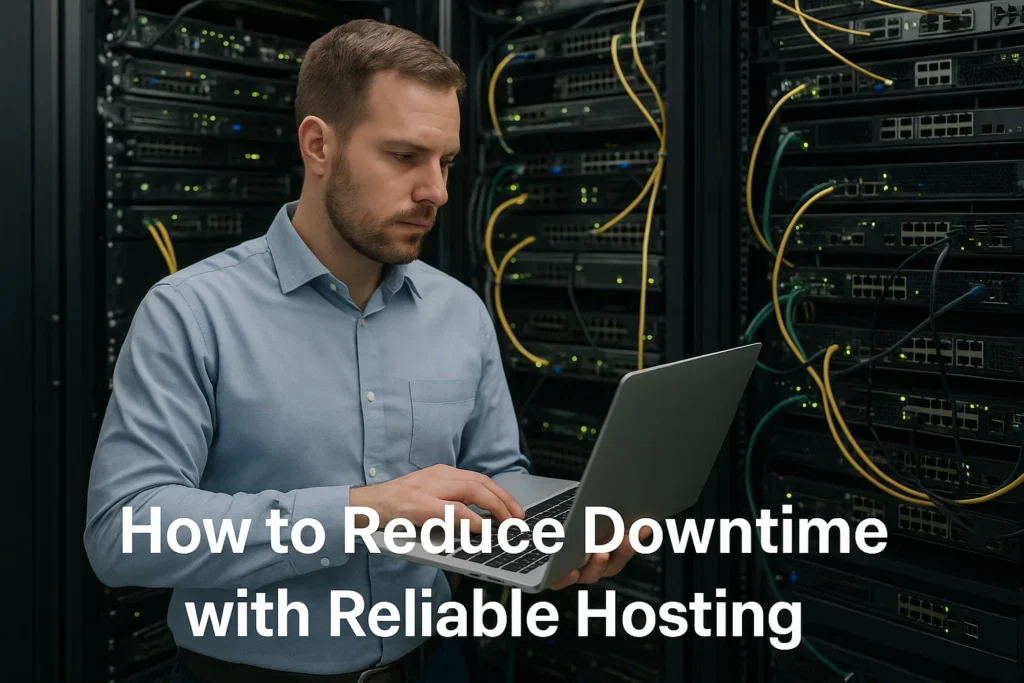In today’s fast-paced digital landscape, businesses depend heavily on their websites to connect with customers, deliver services, and maintain brand reputation. Whether you run an e-commerce store, a SaaS platform, or a corporate website, uptime plays a crucial role in shaping user experience and ensuring profitability.
A website that goes down frequently can cost more than just revenue—it can damage customer trust, hurt SEO rankings, and undermine the credibility of your brand. This is why choosing reliable hosting and understanding how to reduce downtime should be a top priority for any business.
Downtime is essentially the period when your website becomes inaccessible due to server errors, hardware failures, network issues, or misconfigurations. While no hosting provider can guarantee 100% uptime forever, there are effective ways to minimize downtime and ensure your website remains available almost all the time. Reliable hosting providers often advertise uptime guarantees of 99.9% or more, but achieving this requires not just promises—it requires infrastructure, security, monitoring, and scalability.
In this blog, we will explore how reliable hosting helps reduce downtime, the risks associated with downtime, and strategies you can adopt to keep your website running smoothly around the clock.
Understanding Website Downtime
Website downtime refers to any period during which your website cannot be accessed by users. This can range from a few seconds to several hours depending on the severity of the problem. Downtime can occur for various reasons, including:
- Server crashes due to hardware or software failures.
- Network issues caused by data center connectivity problems.
- Traffic spikes that overwhelm server resources.
- Cyberattacks such as DDoS attacks that flood servers with malicious traffic.
- Maintenance errors when updates or patches are applied incorrectly.
- Power outages at the hosting provider’s data center.
Even a short downtime can disrupt user experience and harm business operations. For example, in the e-commerce industry, every second of downtime may result in lost transactions and dissatisfied customers. Reliable hosting providers take measures to ensure that downtime is minimized through redundant systems, monitoring, and proactive support.
The True Cost of Downtime
The financial and reputational costs of downtime can be severe. According to industry research, the average cost of IT downtime is estimated to be thousands of dollars per minute for businesses, depending on their size and industry. For e-commerce giants, a few minutes of downtime can translate into millions in lost sales.
Some of the most significant impacts of downtime include:
- Revenue Loss – Customers who cannot access your website may abandon their purchase and choose a competitor.
- Customer Dissatisfaction – Frequent downtime creates frustration, leading to reduced loyalty and negative reviews.
- Damage to Reputation – Your brand’s credibility is harmed if users consistently encounter errors or downtime.
- SEO Penalties – Search engines like Google may lower your ranking if your site is inaccessible during crawls.
- Operational Disruptions – Internal teams relying on online tools may be affected, reducing productivity.
By investing in reliable hosting, you not only reduce downtime but also protect your business from these cascading negative effects.
Role of Reliable Hosting in Reducing Downtime
Reliable hosting is at the core of keeping your website online and accessible. Here’s how quality hosting services contribute to minimizing downtime:
1. High Uptime Guarantees
Trusted hosting providers usually offer uptime guarantees of 99.9% or higher. This translates to just a few minutes of downtime per month. They achieve this through robust infrastructure, redundant systems, and proactive monitoring.
2. Redundant Infrastructure
Reliable hosting companies operate multiple data centers with redundant power supplies, cooling systems, and network connectivity. If one server or system fails, traffic is rerouted seamlessly to another.
3. 24/7 Monitoring and Support
Top hosting providers constantly monitor servers and networks for performance issues. Their support teams are available 24/7 to quickly resolve potential problems before they cause downtime.
4. Scalability
When your website experiences sudden spikes in traffic, reliable hosting ensures resources are automatically scaled up to handle the load, preventing crashes.
5. Security Measures
Many downtime incidents are caused by cyberattacks. Reliable hosts implement firewalls, DDoS protection, and malware scanning to safeguard your website.
6. Backup and Disaster Recovery
Even in the event of a major issue, reliable hosting providers maintain regular backups and disaster recovery plans to restore your site quickly.
Choosing the Right Hosting to Reduce Downtime
Not all hosting solutions are created equal. The hosting type you select plays a critical role in your website’s uptime. Let’s explore the most common hosting types and their reliability levels:
Shared Hosting
Shared hosting is the most affordable option, where multiple websites share resources on a single server. While cost-effective, it may result in downtime if one site on the server experiences high traffic or security issues.
Virtual Private Server (VPS) Hosting
VPS hosting offers more dedicated resources than shared hosting, reducing the risk of downtime caused by other users. It provides a good balance between affordability and reliability.
Dedicated Hosting
With dedicated hosting, you rent an entire server exclusively for your website. This ensures maximum performance and reduces downtime risks significantly, but it comes at a higher cost.
Cloud Hosting
Cloud hosting distributes your website across multiple servers in a network. This setup is highly reliable since if one server fails, another takes over. It is an excellent choice for reducing downtime.
Managed Hosting
Managed hosting services include professional management, security, updates, and monitoring, allowing you to focus on your business while experts minimize downtime risks.
Best Practices to Reduce Downtime
Even with reliable hosting, website owners should take proactive steps to minimize downtime. Here are some proven strategies:
Regular Monitoring
Use monitoring tools such as Pingdom, UptimeRobot, or Site24x7 to track uptime and receive alerts if your site goes down.
Frequent Backups
Ensure regular backups of your website so you can restore it quickly if downtime occurs due to data corruption or security breaches.
Optimize Website Performance
Heavy websites with slow-loading scripts or poorly optimized databases can crash servers. Regularly optimize performance to reduce the load on your hosting environment.
Stay Updated
Keep your CMS, plugins, and themes updated to avoid vulnerabilities that hackers could exploit to cause downtime.
Content Delivery Network (CDN)
A CDN distributes website content across global servers, reducing downtime risks caused by server overloads or network failures.
Implement Strong Security Measures
Secure your website with SSL certificates, firewalls, and malware scanners to reduce downtime caused by cyber threats.
Real-World Examples of Downtime Impact
Many well-known companies have experienced downtime, highlighting the importance of reliable hosting:
- Amazon – In 2013, Amazon faced a 30-minute outage that reportedly cost the company over $66,000 per minute.
- Google – Even tech giants are not immune. In 2019, a Google outage caused widespread disruption to Gmail, YouTube, and other services.
- Slack – In 2021, Slack went down globally for several hours, impacting businesses that relied on the tool for communication.
These examples show that downtime can affect businesses of all sizes. While no system can promise 100% uptime, investing in reliable hosting and implementing best practices significantly reduces risks.
Future of Hosting and Uptime Reliability
With technological advancements, hosting providers are becoming more efficient at minimizing downtime. Artificial intelligence (AI) and machine learning are increasingly being used to predict server failures before they happen. Edge computing is reducing latency and improving reliability, while cloud infrastructure continues to offer redundancy and scalability.
In the future, businesses can expect hosting solutions to evolve toward even higher levels of reliability, self-healing servers, and fully automated monitoring systems that drastically cut downtime.
Final Thoughts
Website downtime is not just an inconvenience—it’s a business threat that impacts revenue, customer trust, and brand image. By choosing reliable hosting and following best practices, you can drastically reduce downtime and ensure your website remains available to users whenever they need it.
Reliable hosting is more than just a technical service; it’s an investment in your brand’s long-term success. Businesses that prioritize uptime will always have a competitive edge, as they provide seamless experiences that customers can rely on.
The key lies in carefully selecting a hosting provider that offers high uptime guarantees, redundancy, proactive monitoring, and security. Combined with your own best practices such as regular backups, performance optimization, and strong security measures, these efforts will help you keep downtime to a minimum.
Remember, in the digital age, every second counts, and ensuring your website is online at all times is critical to business growth.


